A Study on the Impact of Shadow Education on Student Success
VerifiedAdded on 2020/03/16
|41
|11672
|108
Report
AI Summary
This report investigates the impact of shadow education on secondary school students in the Maldives, focusing on the benefits and drawbacks of private tutoring. The study employs a qualitative descriptive approach, using semi-structured interviews with eight participants, including students and teachers involved and not involved in private tutoring. The findings reveal that shadow education offers advantages such as personalized attention and exam preparation, potentially boosting academic success. However, the report also highlights potential adverse effects on students' mental health if shadow education is not managed properly. The research aims to address the gap in understanding the effects of shadow education, providing insights for parents and educators, while acknowledging the need for further quantitative research to validate the findings. The study also explores the challenges faced by students not taking private tutoring. The report concludes that shadow education has a favorable effect on academic achievement, but it is important to take into consideration the potential negative effects.
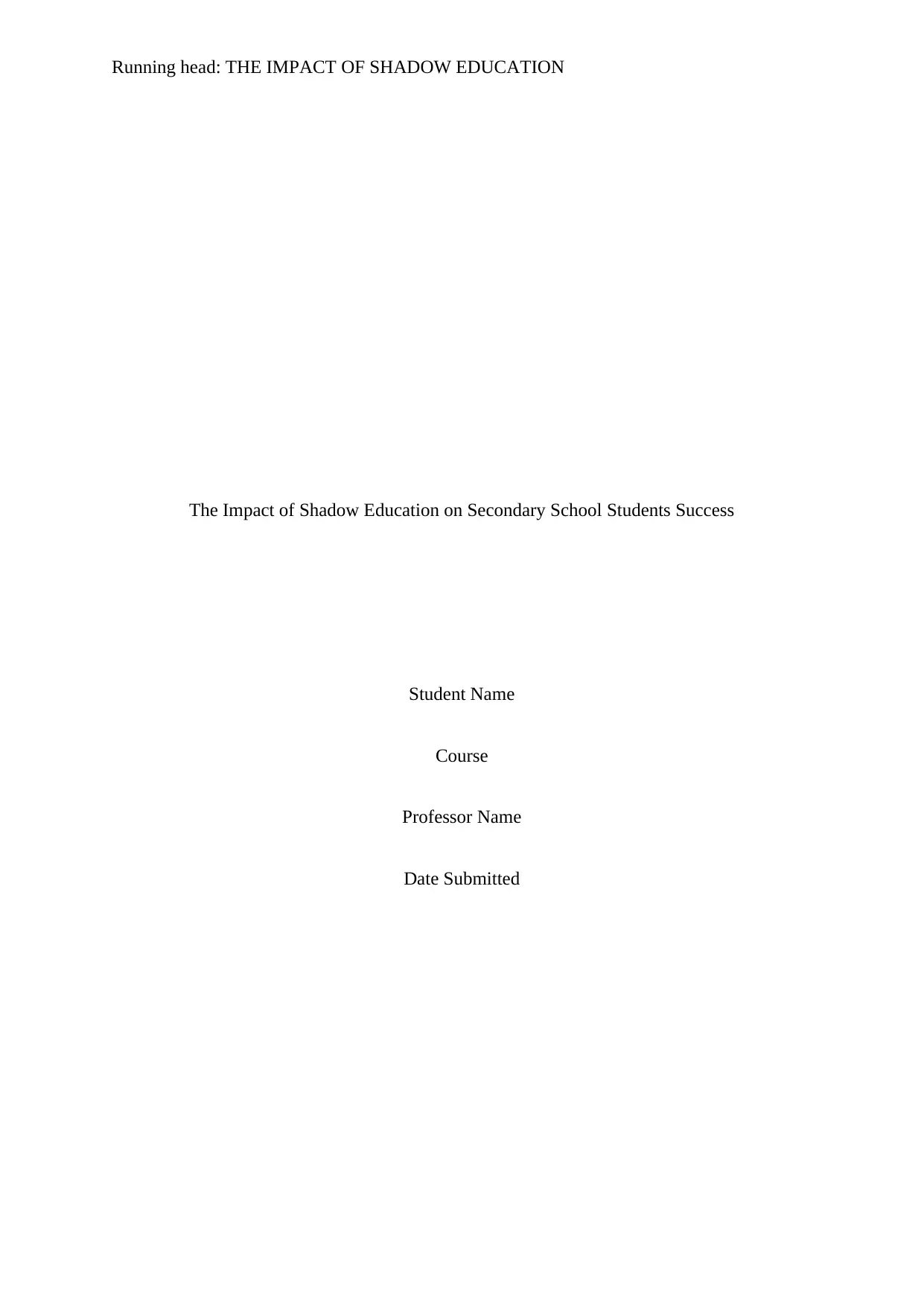
Running head: THE IMPACT OF SHADOW EDUCATION
The Impact of Shadow Education on Secondary School Students Success
Student Name
Course
Professor Name
Date Submitted
The Impact of Shadow Education on Secondary School Students Success
Student Name
Course
Professor Name
Date Submitted
Paraphrase This Document
Need a fresh take? Get an instant paraphrase of this document with our AI Paraphraser
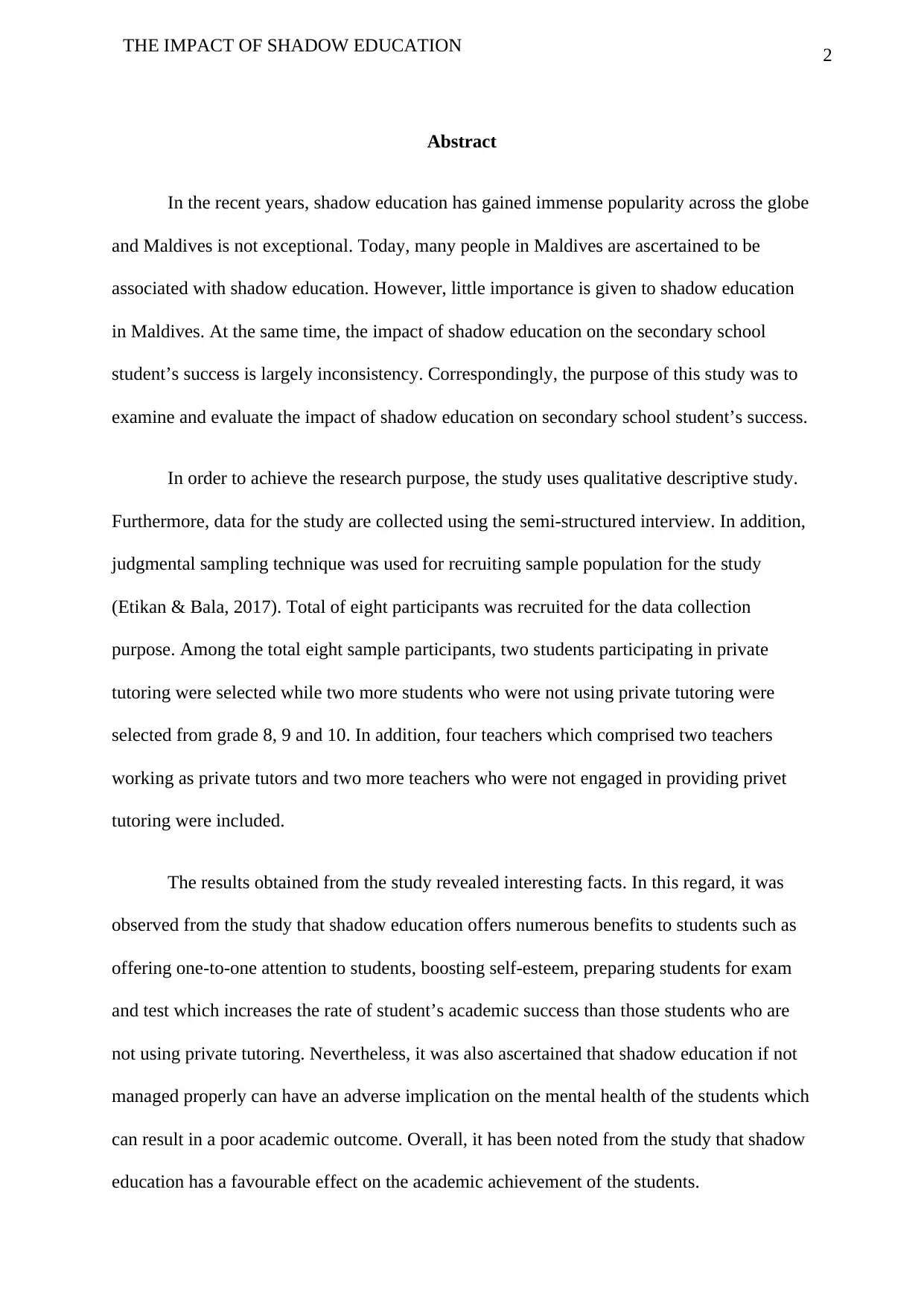
2
THE IMPACT OF SHADOW EDUCATION
Abstract
In the recent years, shadow education has gained immense popularity across the globe
and Maldives is not exceptional. Today, many people in Maldives are ascertained to be
associated with shadow education. However, little importance is given to shadow education
in Maldives. At the same time, the impact of shadow education on the secondary school
student’s success is largely inconsistency. Correspondingly, the purpose of this study was to
examine and evaluate the impact of shadow education on secondary school student’s success.
In order to achieve the research purpose, the study uses qualitative descriptive study.
Furthermore, data for the study are collected using the semi-structured interview. In addition,
judgmental sampling technique was used for recruiting sample population for the study
(Etikan & Bala, 2017). Total of eight participants was recruited for the data collection
purpose. Among the total eight sample participants, two students participating in private
tutoring were selected while two more students who were not using private tutoring were
selected from grade 8, 9 and 10. In addition, four teachers which comprised two teachers
working as private tutors and two more teachers who were not engaged in providing privet
tutoring were included.
The results obtained from the study revealed interesting facts. In this regard, it was
observed from the study that shadow education offers numerous benefits to students such as
offering one-to-one attention to students, boosting self-esteem, preparing students for exam
and test which increases the rate of student’s academic success than those students who are
not using private tutoring. Nevertheless, it was also ascertained that shadow education if not
managed properly can have an adverse implication on the mental health of the students which
can result in a poor academic outcome. Overall, it has been noted from the study that shadow
education has a favourable effect on the academic achievement of the students.
THE IMPACT OF SHADOW EDUCATION
Abstract
In the recent years, shadow education has gained immense popularity across the globe
and Maldives is not exceptional. Today, many people in Maldives are ascertained to be
associated with shadow education. However, little importance is given to shadow education
in Maldives. At the same time, the impact of shadow education on the secondary school
student’s success is largely inconsistency. Correspondingly, the purpose of this study was to
examine and evaluate the impact of shadow education on secondary school student’s success.
In order to achieve the research purpose, the study uses qualitative descriptive study.
Furthermore, data for the study are collected using the semi-structured interview. In addition,
judgmental sampling technique was used for recruiting sample population for the study
(Etikan & Bala, 2017). Total of eight participants was recruited for the data collection
purpose. Among the total eight sample participants, two students participating in private
tutoring were selected while two more students who were not using private tutoring were
selected from grade 8, 9 and 10. In addition, four teachers which comprised two teachers
working as private tutors and two more teachers who were not engaged in providing privet
tutoring were included.
The results obtained from the study revealed interesting facts. In this regard, it was
observed from the study that shadow education offers numerous benefits to students such as
offering one-to-one attention to students, boosting self-esteem, preparing students for exam
and test which increases the rate of student’s academic success than those students who are
not using private tutoring. Nevertheless, it was also ascertained that shadow education if not
managed properly can have an adverse implication on the mental health of the students which
can result in a poor academic outcome. Overall, it has been noted from the study that shadow
education has a favourable effect on the academic achievement of the students.
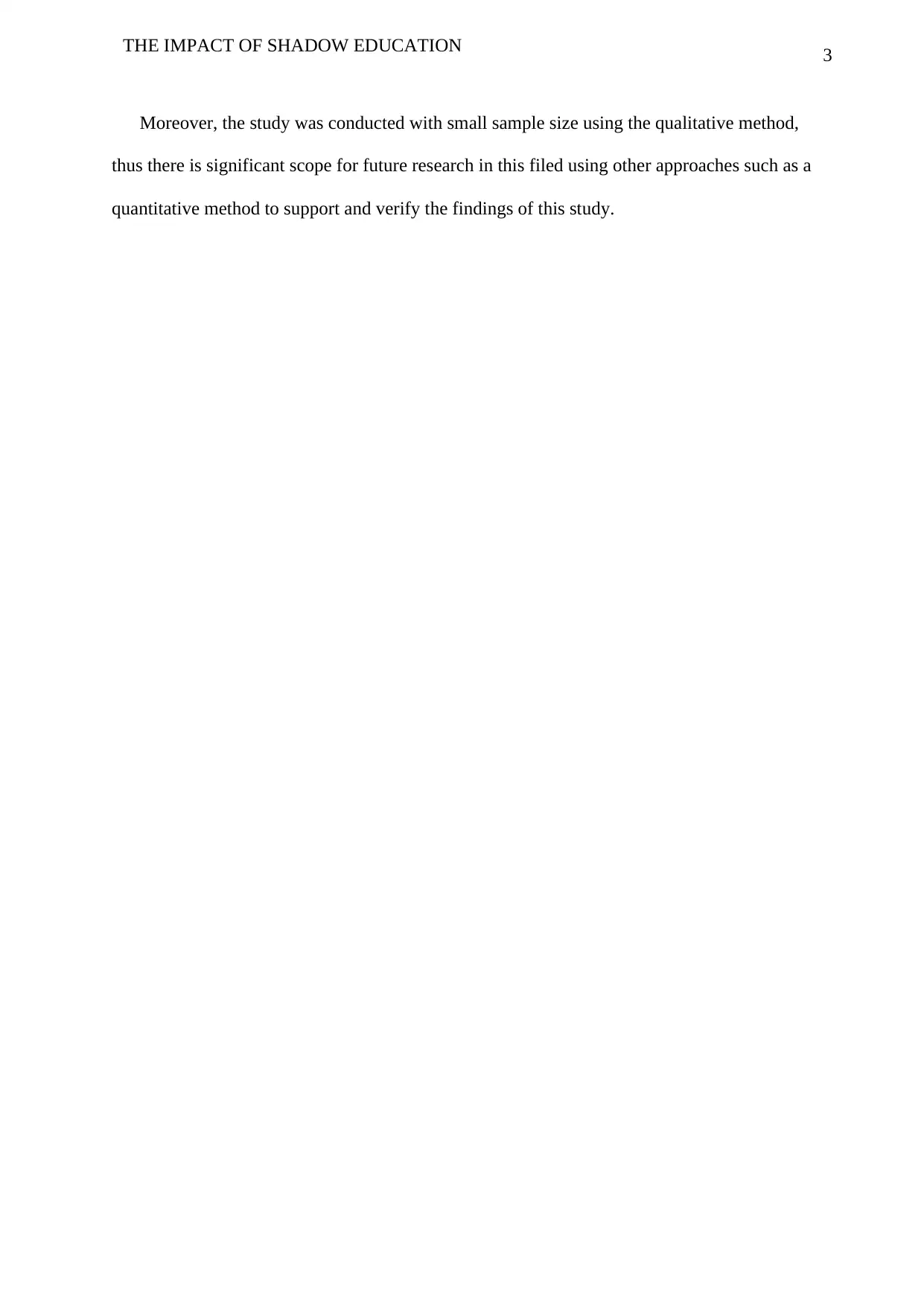
3
THE IMPACT OF SHADOW EDUCATION
Moreover, the study was conducted with small sample size using the qualitative method,
thus there is significant scope for future research in this filed using other approaches such as a
quantitative method to support and verify the findings of this study.
THE IMPACT OF SHADOW EDUCATION
Moreover, the study was conducted with small sample size using the qualitative method,
thus there is significant scope for future research in this filed using other approaches such as a
quantitative method to support and verify the findings of this study.
⊘ This is a preview!⊘
Do you want full access?
Subscribe today to unlock all pages.

Trusted by 1+ million students worldwide
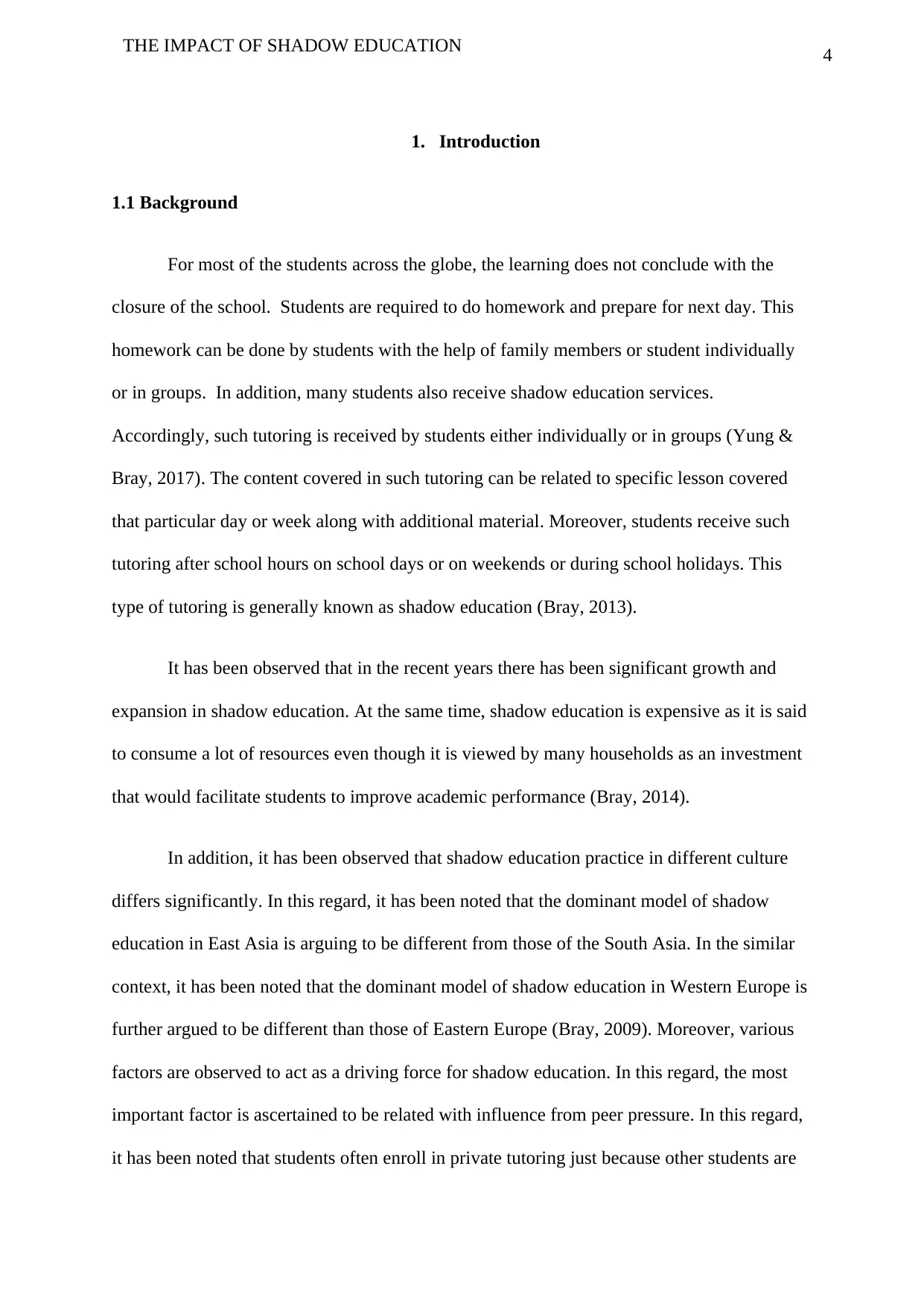
4
THE IMPACT OF SHADOW EDUCATION
1. Introduction
1.1 Background
For most of the students across the globe, the learning does not conclude with the
closure of the school. Students are required to do homework and prepare for next day. This
homework can be done by students with the help of family members or student individually
or in groups. In addition, many students also receive shadow education services.
Accordingly, such tutoring is received by students either individually or in groups (Yung &
Bray, 2017). The content covered in such tutoring can be related to specific lesson covered
that particular day or week along with additional material. Moreover, students receive such
tutoring after school hours on school days or on weekends or during school holidays. This
type of tutoring is generally known as shadow education (Bray, 2013).
It has been observed that in the recent years there has been significant growth and
expansion in shadow education. At the same time, shadow education is expensive as it is said
to consume a lot of resources even though it is viewed by many households as an investment
that would facilitate students to improve academic performance (Bray, 2014).
In addition, it has been observed that shadow education practice in different culture
differs significantly. In this regard, it has been noted that the dominant model of shadow
education in East Asia is arguing to be different from those of the South Asia. In the similar
context, it has been noted that the dominant model of shadow education in Western Europe is
further argued to be different than those of Eastern Europe (Bray, 2009). Moreover, various
factors are observed to act as a driving force for shadow education. In this regard, the most
important factor is ascertained to be related with influence from peer pressure. In this regard,
it has been noted that students often enroll in private tutoring just because other students are
THE IMPACT OF SHADOW EDUCATION
1. Introduction
1.1 Background
For most of the students across the globe, the learning does not conclude with the
closure of the school. Students are required to do homework and prepare for next day. This
homework can be done by students with the help of family members or student individually
or in groups. In addition, many students also receive shadow education services.
Accordingly, such tutoring is received by students either individually or in groups (Yung &
Bray, 2017). The content covered in such tutoring can be related to specific lesson covered
that particular day or week along with additional material. Moreover, students receive such
tutoring after school hours on school days or on weekends or during school holidays. This
type of tutoring is generally known as shadow education (Bray, 2013).
It has been observed that in the recent years there has been significant growth and
expansion in shadow education. At the same time, shadow education is expensive as it is said
to consume a lot of resources even though it is viewed by many households as an investment
that would facilitate students to improve academic performance (Bray, 2014).
In addition, it has been observed that shadow education practice in different culture
differs significantly. In this regard, it has been noted that the dominant model of shadow
education in East Asia is arguing to be different from those of the South Asia. In the similar
context, it has been noted that the dominant model of shadow education in Western Europe is
further argued to be different than those of Eastern Europe (Bray, 2009). Moreover, various
factors are observed to act as a driving force for shadow education. In this regard, the most
important factor is ascertained to be related with influence from peer pressure. In this regard,
it has been noted that students often enroll in private tutoring just because other students are
Paraphrase This Document
Need a fresh take? Get an instant paraphrase of this document with our AI Paraphraser
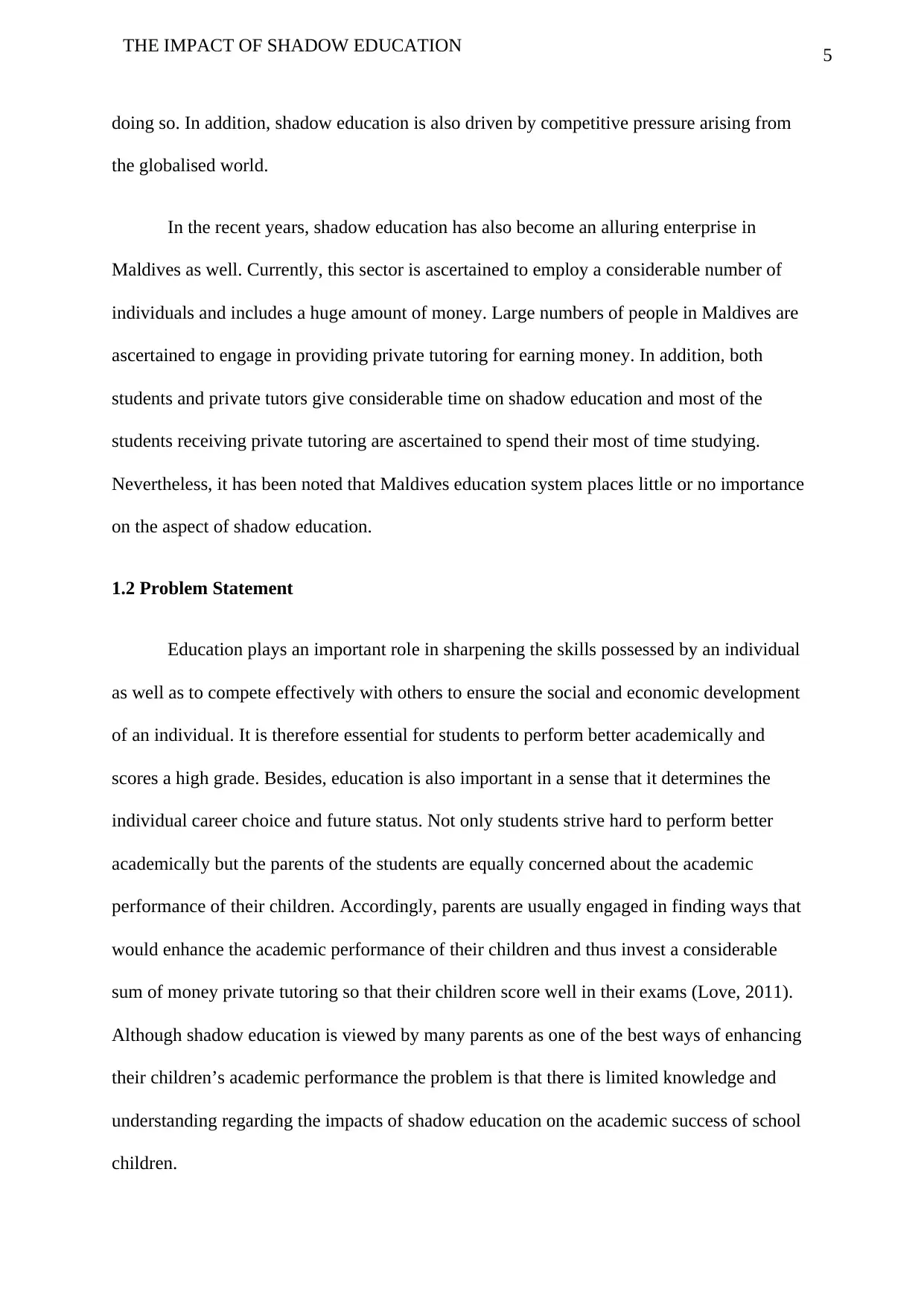
5
THE IMPACT OF SHADOW EDUCATION
doing so. In addition, shadow education is also driven by competitive pressure arising from
the globalised world.
In the recent years, shadow education has also become an alluring enterprise in
Maldives as well. Currently, this sector is ascertained to employ a considerable number of
individuals and includes a huge amount of money. Large numbers of people in Maldives are
ascertained to engage in providing private tutoring for earning money. In addition, both
students and private tutors give considerable time on shadow education and most of the
students receiving private tutoring are ascertained to spend their most of time studying.
Nevertheless, it has been noted that Maldives education system places little or no importance
on the aspect of shadow education.
1.2 Problem Statement
Education plays an important role in sharpening the skills possessed by an individual
as well as to compete effectively with others to ensure the social and economic development
of an individual. It is therefore essential for students to perform better academically and
scores a high grade. Besides, education is also important in a sense that it determines the
individual career choice and future status. Not only students strive hard to perform better
academically but the parents of the students are equally concerned about the academic
performance of their children. Accordingly, parents are usually engaged in finding ways that
would enhance the academic performance of their children and thus invest a considerable
sum of money private tutoring so that their children score well in their exams (Love, 2011).
Although shadow education is viewed by many parents as one of the best ways of enhancing
their children’s academic performance the problem is that there is limited knowledge and
understanding regarding the impacts of shadow education on the academic success of school
children.
THE IMPACT OF SHADOW EDUCATION
doing so. In addition, shadow education is also driven by competitive pressure arising from
the globalised world.
In the recent years, shadow education has also become an alluring enterprise in
Maldives as well. Currently, this sector is ascertained to employ a considerable number of
individuals and includes a huge amount of money. Large numbers of people in Maldives are
ascertained to engage in providing private tutoring for earning money. In addition, both
students and private tutors give considerable time on shadow education and most of the
students receiving private tutoring are ascertained to spend their most of time studying.
Nevertheless, it has been noted that Maldives education system places little or no importance
on the aspect of shadow education.
1.2 Problem Statement
Education plays an important role in sharpening the skills possessed by an individual
as well as to compete effectively with others to ensure the social and economic development
of an individual. It is therefore essential for students to perform better academically and
scores a high grade. Besides, education is also important in a sense that it determines the
individual career choice and future status. Not only students strive hard to perform better
academically but the parents of the students are equally concerned about the academic
performance of their children. Accordingly, parents are usually engaged in finding ways that
would enhance the academic performance of their children and thus invest a considerable
sum of money private tutoring so that their children score well in their exams (Love, 2011).
Although shadow education is viewed by many parents as one of the best ways of enhancing
their children’s academic performance the problem is that there is limited knowledge and
understanding regarding the impacts of shadow education on the academic success of school
children.
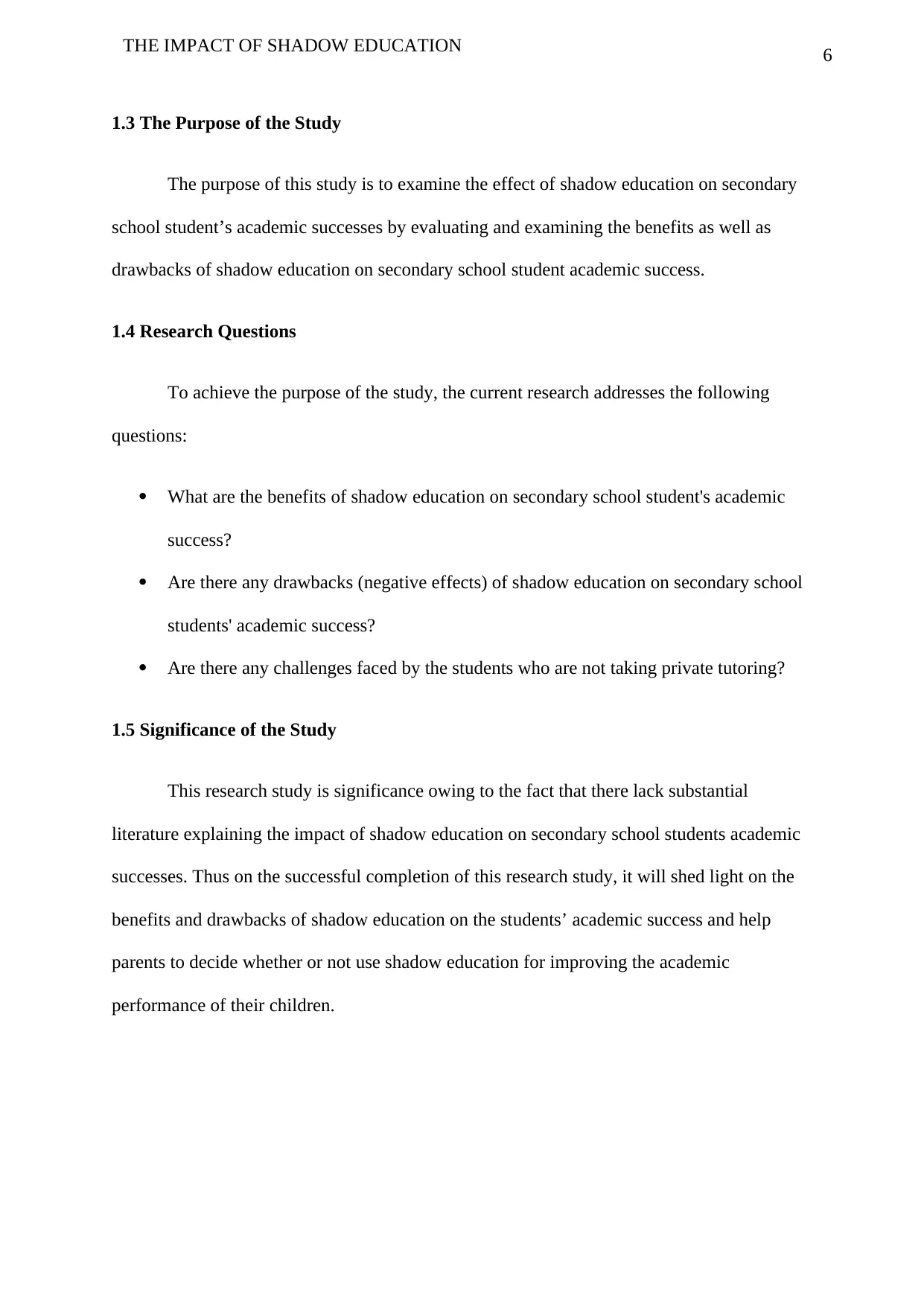
6
THE IMPACT OF SHADOW EDUCATION
1.3 The Purpose of the Study
The purpose of this study is to examine the effect of shadow education on secondary
school student’s academic successes by evaluating and examining the benefits as well as
drawbacks of shadow education on secondary school student academic success.
1.4 Research Questions
To achieve the purpose of the study, the current research addresses the following
questions:
What are the benefits of shadow education on secondary school student's academic
success?
Are there any drawbacks (negative effects) of shadow education on secondary school
students' academic success?
Are there any challenges faced by the students who are not taking private tutoring?
1.5 Significance of the Study
This research study is significance owing to the fact that there lack substantial
literature explaining the impact of shadow education on secondary school students academic
successes. Thus on the successful completion of this research study, it will shed light on the
benefits and drawbacks of shadow education on the students’ academic success and help
parents to decide whether or not use shadow education for improving the academic
performance of their children.
THE IMPACT OF SHADOW EDUCATION
1.3 The Purpose of the Study
The purpose of this study is to examine the effect of shadow education on secondary
school student’s academic successes by evaluating and examining the benefits as well as
drawbacks of shadow education on secondary school student academic success.
1.4 Research Questions
To achieve the purpose of the study, the current research addresses the following
questions:
What are the benefits of shadow education on secondary school student's academic
success?
Are there any drawbacks (negative effects) of shadow education on secondary school
students' academic success?
Are there any challenges faced by the students who are not taking private tutoring?
1.5 Significance of the Study
This research study is significance owing to the fact that there lack substantial
literature explaining the impact of shadow education on secondary school students academic
successes. Thus on the successful completion of this research study, it will shed light on the
benefits and drawbacks of shadow education on the students’ academic success and help
parents to decide whether or not use shadow education for improving the academic
performance of their children.
⊘ This is a preview!⊘
Do you want full access?
Subscribe today to unlock all pages.

Trusted by 1+ million students worldwide
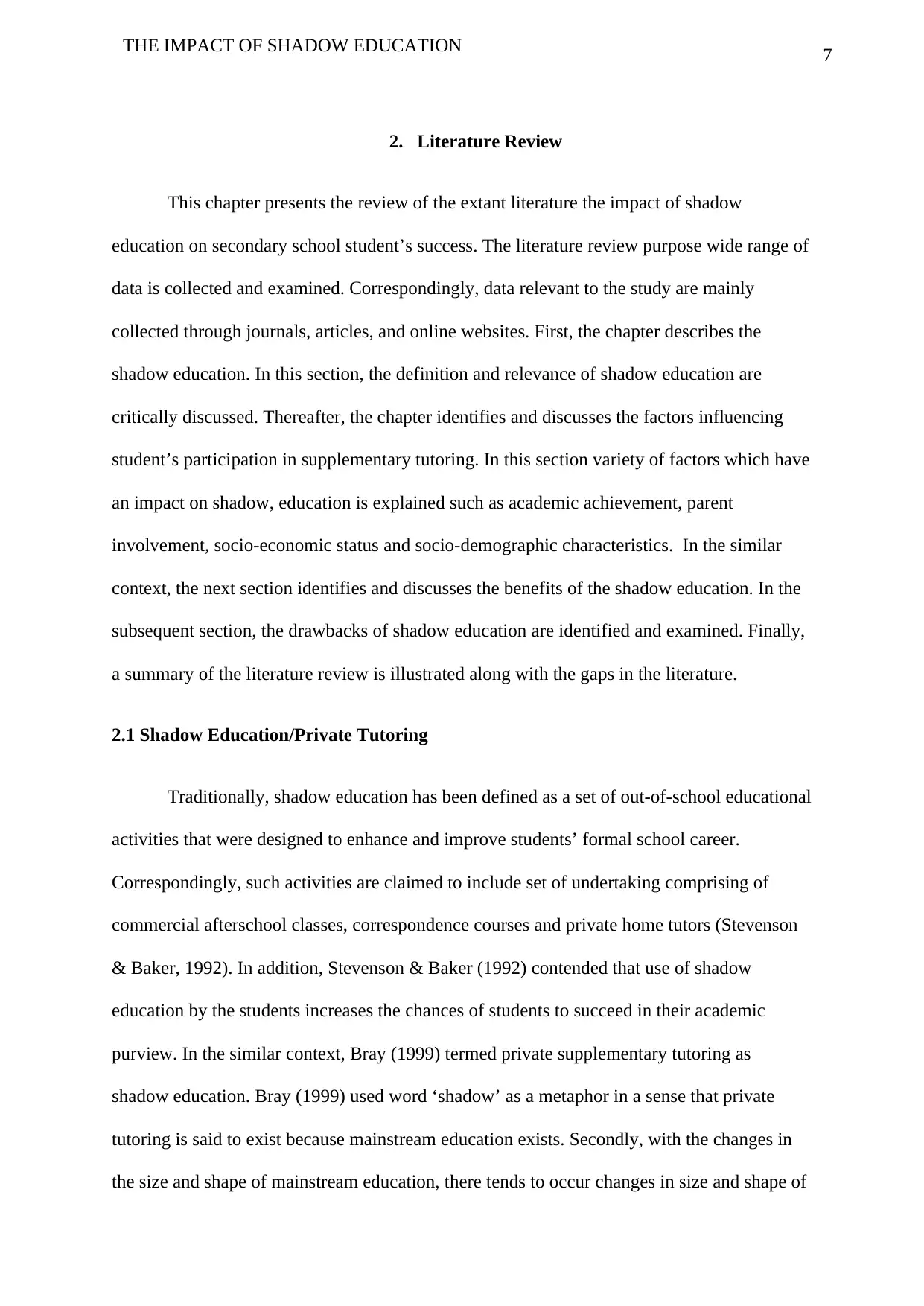
7
THE IMPACT OF SHADOW EDUCATION
2. Literature Review
This chapter presents the review of the extant literature the impact of shadow
education on secondary school student’s success. The literature review purpose wide range of
data is collected and examined. Correspondingly, data relevant to the study are mainly
collected through journals, articles, and online websites. First, the chapter describes the
shadow education. In this section, the definition and relevance of shadow education are
critically discussed. Thereafter, the chapter identifies and discusses the factors influencing
student’s participation in supplementary tutoring. In this section variety of factors which have
an impact on shadow, education is explained such as academic achievement, parent
involvement, socio-economic status and socio-demographic characteristics. In the similar
context, the next section identifies and discusses the benefits of the shadow education. In the
subsequent section, the drawbacks of shadow education are identified and examined. Finally,
a summary of the literature review is illustrated along with the gaps in the literature.
2.1 Shadow Education/Private Tutoring
Traditionally, shadow education has been defined as a set of out-of-school educational
activities that were designed to enhance and improve students’ formal school career.
Correspondingly, such activities are claimed to include set of undertaking comprising of
commercial afterschool classes, correspondence courses and private home tutors (Stevenson
& Baker, 1992). In addition, Stevenson & Baker (1992) contended that use of shadow
education by the students increases the chances of students to succeed in their academic
purview. In the similar context, Bray (1999) termed private supplementary tutoring as
shadow education. Bray (1999) used word ‘shadow’ as a metaphor in a sense that private
tutoring is said to exist because mainstream education exists. Secondly, with the changes in
the size and shape of mainstream education, there tends to occur changes in size and shape of
THE IMPACT OF SHADOW EDUCATION
2. Literature Review
This chapter presents the review of the extant literature the impact of shadow
education on secondary school student’s success. The literature review purpose wide range of
data is collected and examined. Correspondingly, data relevant to the study are mainly
collected through journals, articles, and online websites. First, the chapter describes the
shadow education. In this section, the definition and relevance of shadow education are
critically discussed. Thereafter, the chapter identifies and discusses the factors influencing
student’s participation in supplementary tutoring. In this section variety of factors which have
an impact on shadow, education is explained such as academic achievement, parent
involvement, socio-economic status and socio-demographic characteristics. In the similar
context, the next section identifies and discusses the benefits of the shadow education. In the
subsequent section, the drawbacks of shadow education are identified and examined. Finally,
a summary of the literature review is illustrated along with the gaps in the literature.
2.1 Shadow Education/Private Tutoring
Traditionally, shadow education has been defined as a set of out-of-school educational
activities that were designed to enhance and improve students’ formal school career.
Correspondingly, such activities are claimed to include set of undertaking comprising of
commercial afterschool classes, correspondence courses and private home tutors (Stevenson
& Baker, 1992). In addition, Stevenson & Baker (1992) contended that use of shadow
education by the students increases the chances of students to succeed in their academic
purview. In the similar context, Bray (1999) termed private supplementary tutoring as
shadow education. Bray (1999) used word ‘shadow’ as a metaphor in a sense that private
tutoring is said to exist because mainstream education exists. Secondly, with the changes in
the size and shape of mainstream education, there tends to occur changes in size and shape of
Paraphrase This Document
Need a fresh take? Get an instant paraphrase of this document with our AI Paraphraser
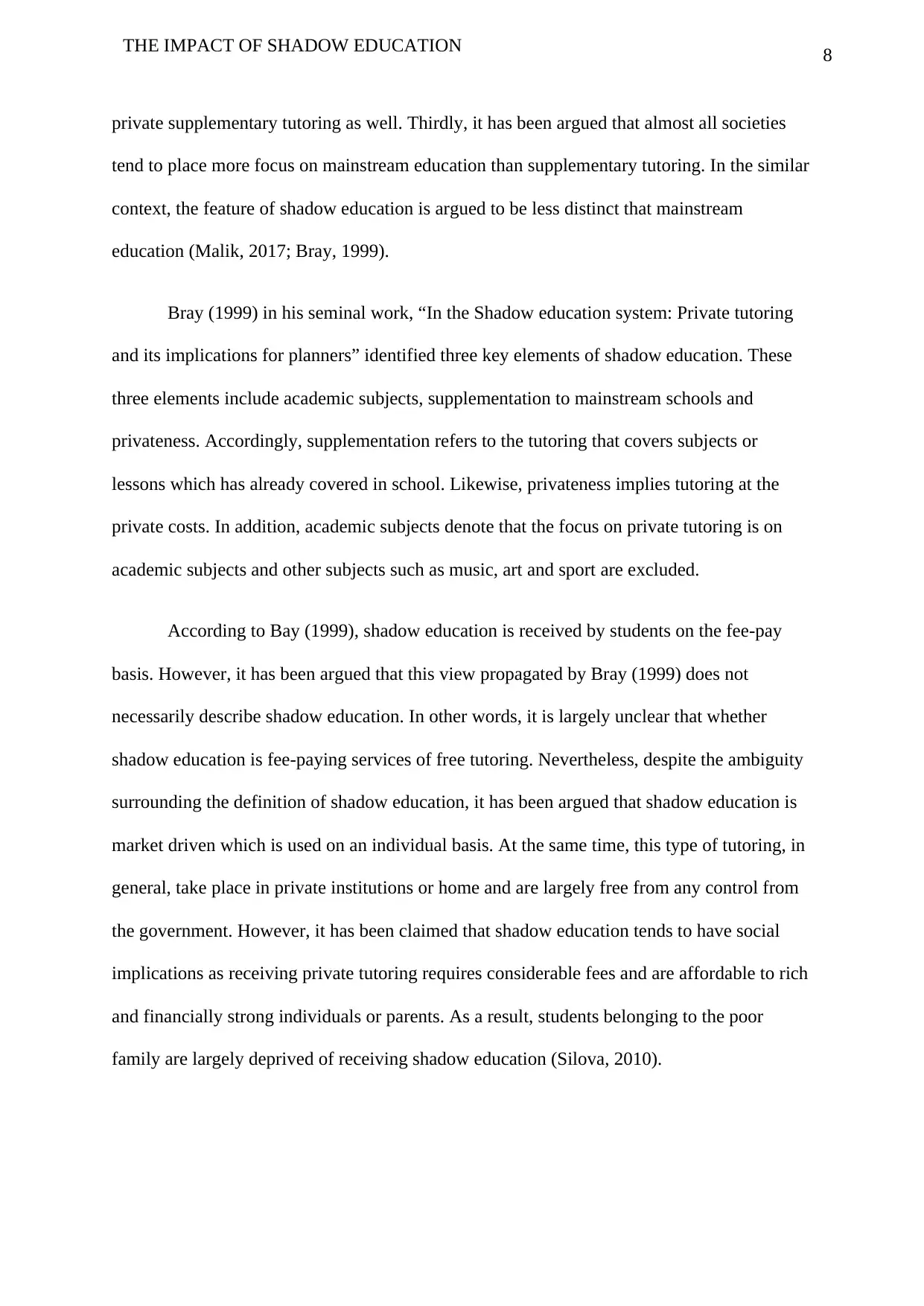
8
THE IMPACT OF SHADOW EDUCATION
private supplementary tutoring as well. Thirdly, it has been argued that almost all societies
tend to place more focus on mainstream education than supplementary tutoring. In the similar
context, the feature of shadow education is argued to be less distinct that mainstream
education (Malik, 2017; Bray, 1999).
Bray (1999) in his seminal work, “In the Shadow education system: Private tutoring
and its implications for planners” identified three key elements of shadow education. These
three elements include academic subjects, supplementation to mainstream schools and
privateness. Accordingly, supplementation refers to the tutoring that covers subjects or
lessons which has already covered in school. Likewise, privateness implies tutoring at the
private costs. In addition, academic subjects denote that the focus on private tutoring is on
academic subjects and other subjects such as music, art and sport are excluded.
According to Bay (1999), shadow education is received by students on the fee-pay
basis. However, it has been argued that this view propagated by Bray (1999) does not
necessarily describe shadow education. In other words, it is largely unclear that whether
shadow education is fee-paying services of free tutoring. Nevertheless, despite the ambiguity
surrounding the definition of shadow education, it has been argued that shadow education is
market driven which is used on an individual basis. At the same time, this type of tutoring, in
general, take place in private institutions or home and are largely free from any control from
the government. However, it has been claimed that shadow education tends to have social
implications as receiving private tutoring requires considerable fees and are affordable to rich
and financially strong individuals or parents. As a result, students belonging to the poor
family are largely deprived of receiving shadow education (Silova, 2010).
THE IMPACT OF SHADOW EDUCATION
private supplementary tutoring as well. Thirdly, it has been argued that almost all societies
tend to place more focus on mainstream education than supplementary tutoring. In the similar
context, the feature of shadow education is argued to be less distinct that mainstream
education (Malik, 2017; Bray, 1999).
Bray (1999) in his seminal work, “In the Shadow education system: Private tutoring
and its implications for planners” identified three key elements of shadow education. These
three elements include academic subjects, supplementation to mainstream schools and
privateness. Accordingly, supplementation refers to the tutoring that covers subjects or
lessons which has already covered in school. Likewise, privateness implies tutoring at the
private costs. In addition, academic subjects denote that the focus on private tutoring is on
academic subjects and other subjects such as music, art and sport are excluded.
According to Bay (1999), shadow education is received by students on the fee-pay
basis. However, it has been argued that this view propagated by Bray (1999) does not
necessarily describe shadow education. In other words, it is largely unclear that whether
shadow education is fee-paying services of free tutoring. Nevertheless, despite the ambiguity
surrounding the definition of shadow education, it has been argued that shadow education is
market driven which is used on an individual basis. At the same time, this type of tutoring, in
general, take place in private institutions or home and are largely free from any control from
the government. However, it has been claimed that shadow education tends to have social
implications as receiving private tutoring requires considerable fees and are affordable to rich
and financially strong individuals or parents. As a result, students belonging to the poor
family are largely deprived of receiving shadow education (Silova, 2010).
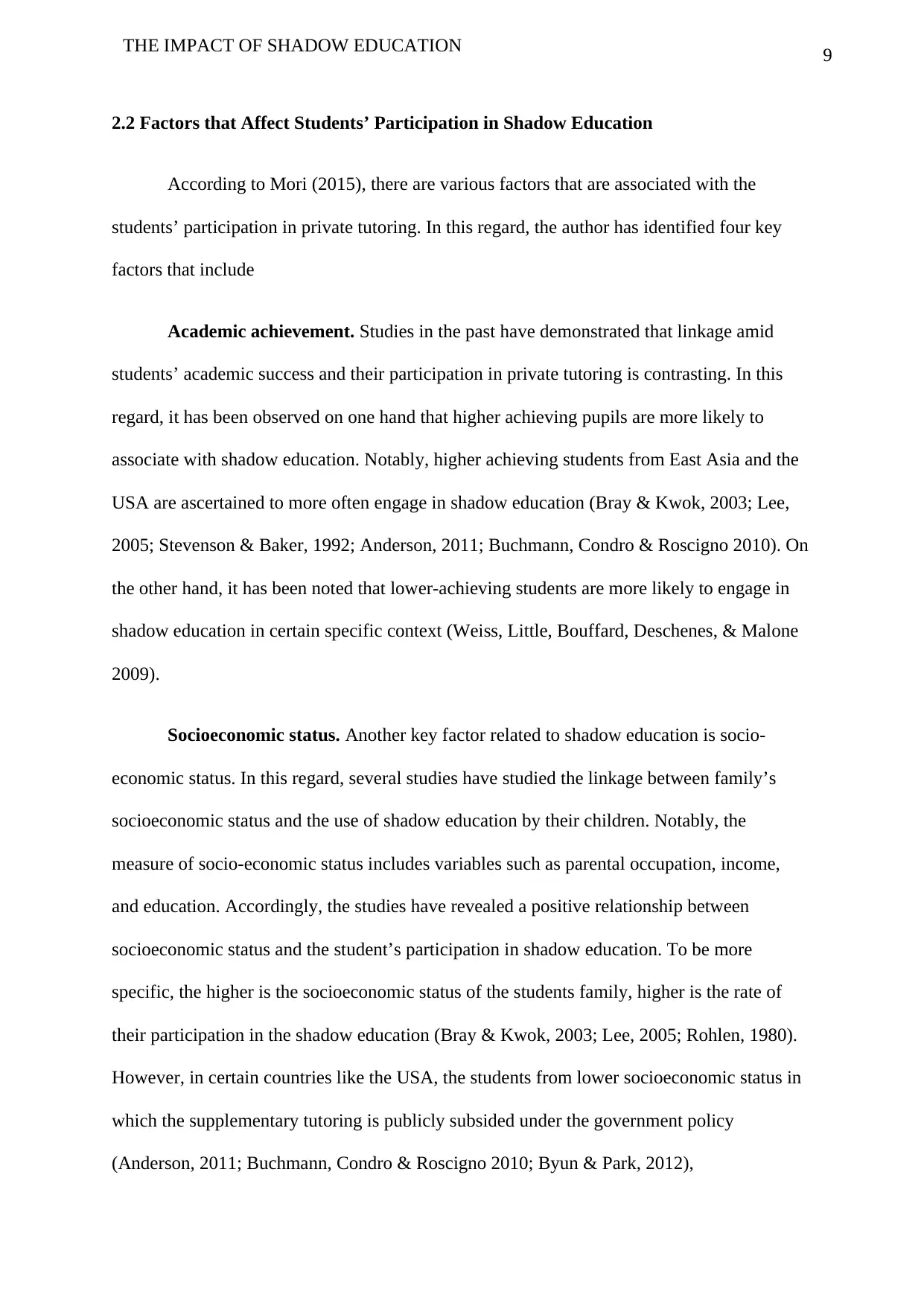
9
THE IMPACT OF SHADOW EDUCATION
2.2 Factors that Affect Students’ Participation in Shadow Education
According to Mori (2015), there are various factors that are associated with the
students’ participation in private tutoring. In this regard, the author has identified four key
factors that include
Academic achievement. Studies in the past have demonstrated that linkage amid
students’ academic success and their participation in private tutoring is contrasting. In this
regard, it has been observed on one hand that higher achieving pupils are more likely to
associate with shadow education. Notably, higher achieving students from East Asia and the
USA are ascertained to more often engage in shadow education (Bray & Kwok, 2003; Lee,
2005; Stevenson & Baker, 1992; Anderson, 2011; Buchmann, Condro & Roscigno 2010). On
the other hand, it has been noted that lower-achieving students are more likely to engage in
shadow education in certain specific context (Weiss, Little, Bouffard, Deschenes, & Malone
2009).
Socioeconomic status. Another key factor related to shadow education is socio-
economic status. In this regard, several studies have studied the linkage between family’s
socioeconomic status and the use of shadow education by their children. Notably, the
measure of socio-economic status includes variables such as parental occupation, income,
and education. Accordingly, the studies have revealed a positive relationship between
socioeconomic status and the student’s participation in shadow education. To be more
specific, the higher is the socioeconomic status of the students family, higher is the rate of
their participation in the shadow education (Bray & Kwok, 2003; Lee, 2005; Rohlen, 1980).
However, in certain countries like the USA, the students from lower socioeconomic status in
which the supplementary tutoring is publicly subsided under the government policy
(Anderson, 2011; Buchmann, Condro & Roscigno 2010; Byun & Park, 2012),
THE IMPACT OF SHADOW EDUCATION
2.2 Factors that Affect Students’ Participation in Shadow Education
According to Mori (2015), there are various factors that are associated with the
students’ participation in private tutoring. In this regard, the author has identified four key
factors that include
Academic achievement. Studies in the past have demonstrated that linkage amid
students’ academic success and their participation in private tutoring is contrasting. In this
regard, it has been observed on one hand that higher achieving pupils are more likely to
associate with shadow education. Notably, higher achieving students from East Asia and the
USA are ascertained to more often engage in shadow education (Bray & Kwok, 2003; Lee,
2005; Stevenson & Baker, 1992; Anderson, 2011; Buchmann, Condro & Roscigno 2010). On
the other hand, it has been noted that lower-achieving students are more likely to engage in
shadow education in certain specific context (Weiss, Little, Bouffard, Deschenes, & Malone
2009).
Socioeconomic status. Another key factor related to shadow education is socio-
economic status. In this regard, several studies have studied the linkage between family’s
socioeconomic status and the use of shadow education by their children. Notably, the
measure of socio-economic status includes variables such as parental occupation, income,
and education. Accordingly, the studies have revealed a positive relationship between
socioeconomic status and the student’s participation in shadow education. To be more
specific, the higher is the socioeconomic status of the students family, higher is the rate of
their participation in the shadow education (Bray & Kwok, 2003; Lee, 2005; Rohlen, 1980).
However, in certain countries like the USA, the students from lower socioeconomic status in
which the supplementary tutoring is publicly subsided under the government policy
(Anderson, 2011; Buchmann, Condro & Roscigno 2010; Byun & Park, 2012),
⊘ This is a preview!⊘
Do you want full access?
Subscribe today to unlock all pages.

Trusted by 1+ million students worldwide
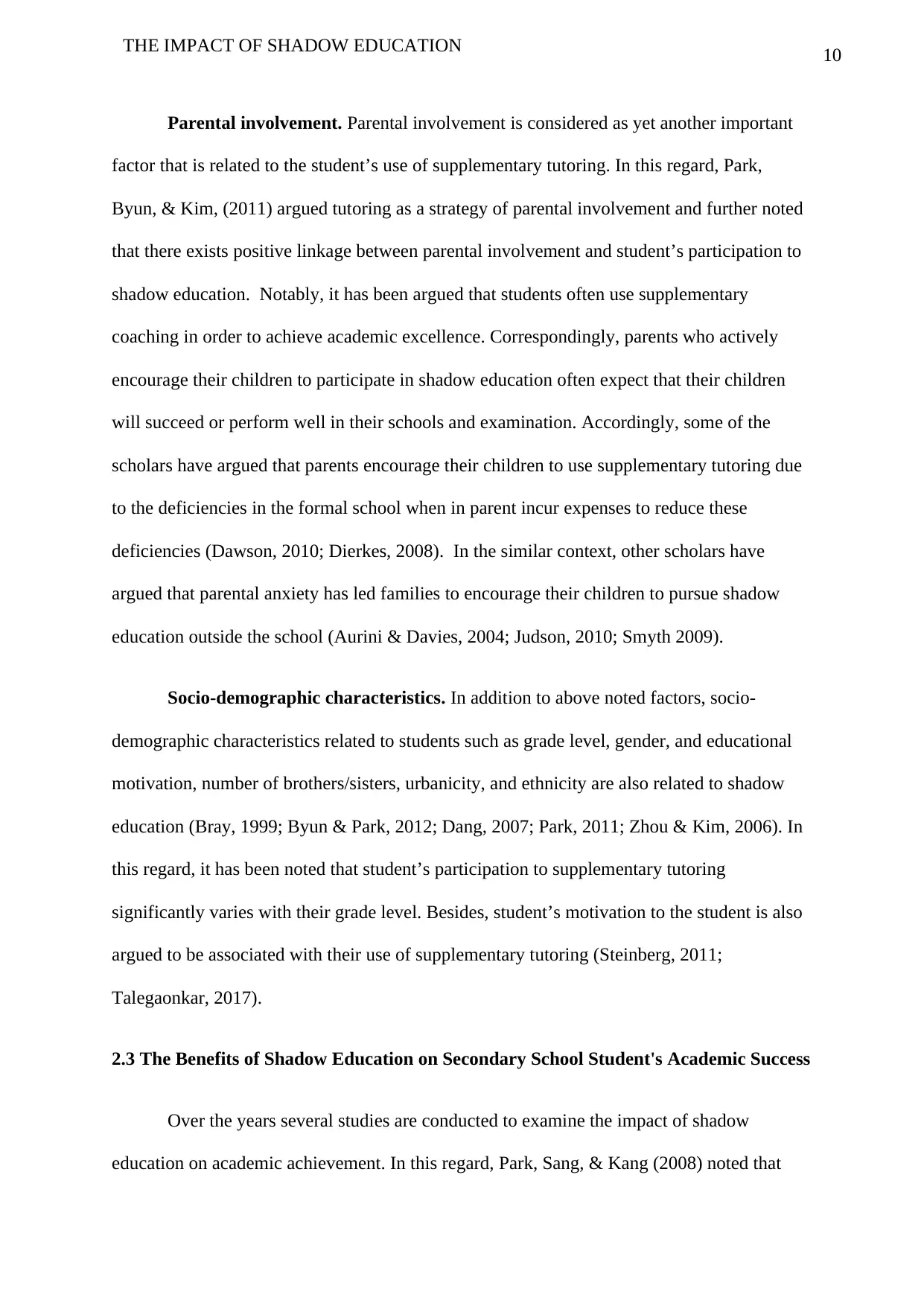
10
THE IMPACT OF SHADOW EDUCATION
Parental involvement. Parental involvement is considered as yet another important
factor that is related to the student’s use of supplementary tutoring. In this regard, Park,
Byun, & Kim, (2011) argued tutoring as a strategy of parental involvement and further noted
that there exists positive linkage between parental involvement and student’s participation to
shadow education. Notably, it has been argued that students often use supplementary
coaching in order to achieve academic excellence. Correspondingly, parents who actively
encourage their children to participate in shadow education often expect that their children
will succeed or perform well in their schools and examination. Accordingly, some of the
scholars have argued that parents encourage their children to use supplementary tutoring due
to the deficiencies in the formal school when in parent incur expenses to reduce these
deficiencies (Dawson, 2010; Dierkes, 2008). In the similar context, other scholars have
argued that parental anxiety has led families to encourage their children to pursue shadow
education outside the school (Aurini & Davies, 2004; Judson, 2010; Smyth 2009).
Socio-demographic characteristics. In addition to above noted factors, socio-
demographic characteristics related to students such as grade level, gender, and educational
motivation, number of brothers/sisters, urbanicity, and ethnicity are also related to shadow
education (Bray, 1999; Byun & Park, 2012; Dang, 2007; Park, 2011; Zhou & Kim, 2006). In
this regard, it has been noted that student’s participation to supplementary tutoring
significantly varies with their grade level. Besides, student’s motivation to the student is also
argued to be associated with their use of supplementary tutoring (Steinberg, 2011;
Talegaonkar, 2017).
2.3 The Benefits of Shadow Education on Secondary School Student's Academic Success
Over the years several studies are conducted to examine the impact of shadow
education on academic achievement. In this regard, Park, Sang, & Kang (2008) noted that
THE IMPACT OF SHADOW EDUCATION
Parental involvement. Parental involvement is considered as yet another important
factor that is related to the student’s use of supplementary tutoring. In this regard, Park,
Byun, & Kim, (2011) argued tutoring as a strategy of parental involvement and further noted
that there exists positive linkage between parental involvement and student’s participation to
shadow education. Notably, it has been argued that students often use supplementary
coaching in order to achieve academic excellence. Correspondingly, parents who actively
encourage their children to participate in shadow education often expect that their children
will succeed or perform well in their schools and examination. Accordingly, some of the
scholars have argued that parents encourage their children to use supplementary tutoring due
to the deficiencies in the formal school when in parent incur expenses to reduce these
deficiencies (Dawson, 2010; Dierkes, 2008). In the similar context, other scholars have
argued that parental anxiety has led families to encourage their children to pursue shadow
education outside the school (Aurini & Davies, 2004; Judson, 2010; Smyth 2009).
Socio-demographic characteristics. In addition to above noted factors, socio-
demographic characteristics related to students such as grade level, gender, and educational
motivation, number of brothers/sisters, urbanicity, and ethnicity are also related to shadow
education (Bray, 1999; Byun & Park, 2012; Dang, 2007; Park, 2011; Zhou & Kim, 2006). In
this regard, it has been noted that student’s participation to supplementary tutoring
significantly varies with their grade level. Besides, student’s motivation to the student is also
argued to be associated with their use of supplementary tutoring (Steinberg, 2011;
Talegaonkar, 2017).
2.3 The Benefits of Shadow Education on Secondary School Student's Academic Success
Over the years several studies are conducted to examine the impact of shadow
education on academic achievement. In this regard, Park, Sang, & Kang (2008) noted that
Paraphrase This Document
Need a fresh take? Get an instant paraphrase of this document with our AI Paraphraser
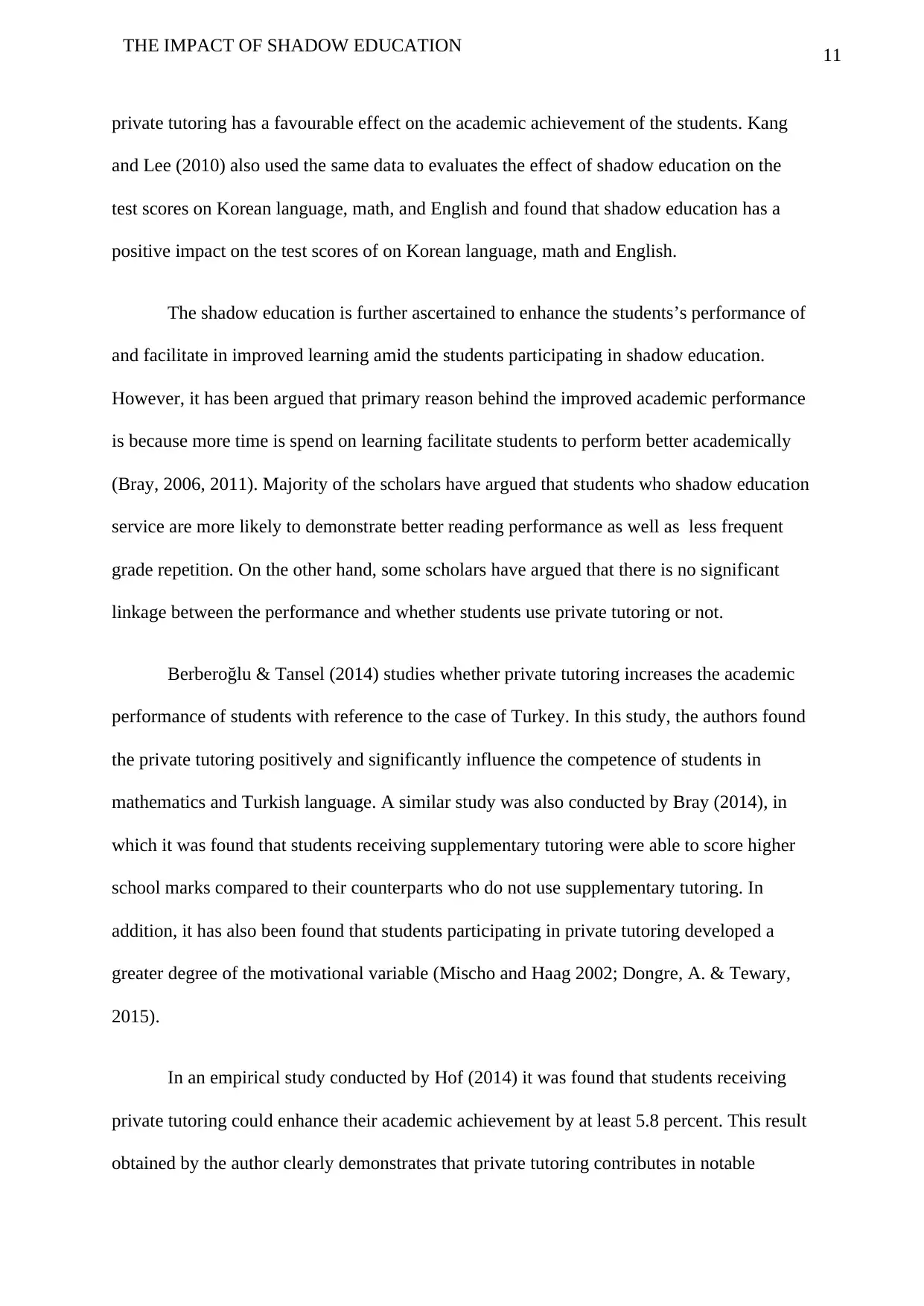
11
THE IMPACT OF SHADOW EDUCATION
private tutoring has a favourable effect on the academic achievement of the students. Kang
and Lee (2010) also used the same data to evaluates the effect of shadow education on the
test scores on Korean language, math, and English and found that shadow education has a
positive impact on the test scores of on Korean language, math and English.
The shadow education is further ascertained to enhance the students’s performance of
and facilitate in improved learning amid the students participating in shadow education.
However, it has been argued that primary reason behind the improved academic performance
is because more time is spend on learning facilitate students to perform better academically
(Bray, 2006, 2011). Majority of the scholars have argued that students who shadow education
service are more likely to demonstrate better reading performance as well as less frequent
grade repetition. On the other hand, some scholars have argued that there is no significant
linkage between the performance and whether students use private tutoring or not.
Berberoğlu & Tansel (2014) studies whether private tutoring increases the academic
performance of students with reference to the case of Turkey. In this study, the authors found
the private tutoring positively and significantly influence the competence of students in
mathematics and Turkish language. A similar study was also conducted by Bray (2014), in
which it was found that students receiving supplementary tutoring were able to score higher
school marks compared to their counterparts who do not use supplementary tutoring. In
addition, it has also been found that students participating in private tutoring developed a
greater degree of the motivational variable (Mischo and Haag 2002; Dongre, A. & Tewary,
2015).
In an empirical study conducted by Hof (2014) it was found that students receiving
private tutoring could enhance their academic achievement by at least 5.8 percent. This result
obtained by the author clearly demonstrates that private tutoring contributes in notable
THE IMPACT OF SHADOW EDUCATION
private tutoring has a favourable effect on the academic achievement of the students. Kang
and Lee (2010) also used the same data to evaluates the effect of shadow education on the
test scores on Korean language, math, and English and found that shadow education has a
positive impact on the test scores of on Korean language, math and English.
The shadow education is further ascertained to enhance the students’s performance of
and facilitate in improved learning amid the students participating in shadow education.
However, it has been argued that primary reason behind the improved academic performance
is because more time is spend on learning facilitate students to perform better academically
(Bray, 2006, 2011). Majority of the scholars have argued that students who shadow education
service are more likely to demonstrate better reading performance as well as less frequent
grade repetition. On the other hand, some scholars have argued that there is no significant
linkage between the performance and whether students use private tutoring or not.
Berberoğlu & Tansel (2014) studies whether private tutoring increases the academic
performance of students with reference to the case of Turkey. In this study, the authors found
the private tutoring positively and significantly influence the competence of students in
mathematics and Turkish language. A similar study was also conducted by Bray (2014), in
which it was found that students receiving supplementary tutoring were able to score higher
school marks compared to their counterparts who do not use supplementary tutoring. In
addition, it has also been found that students participating in private tutoring developed a
greater degree of the motivational variable (Mischo and Haag 2002; Dongre, A. & Tewary,
2015).
In an empirical study conducted by Hof (2014) it was found that students receiving
private tutoring could enhance their academic achievement by at least 5.8 percent. This result
obtained by the author clearly demonstrates that private tutoring contributes in notable
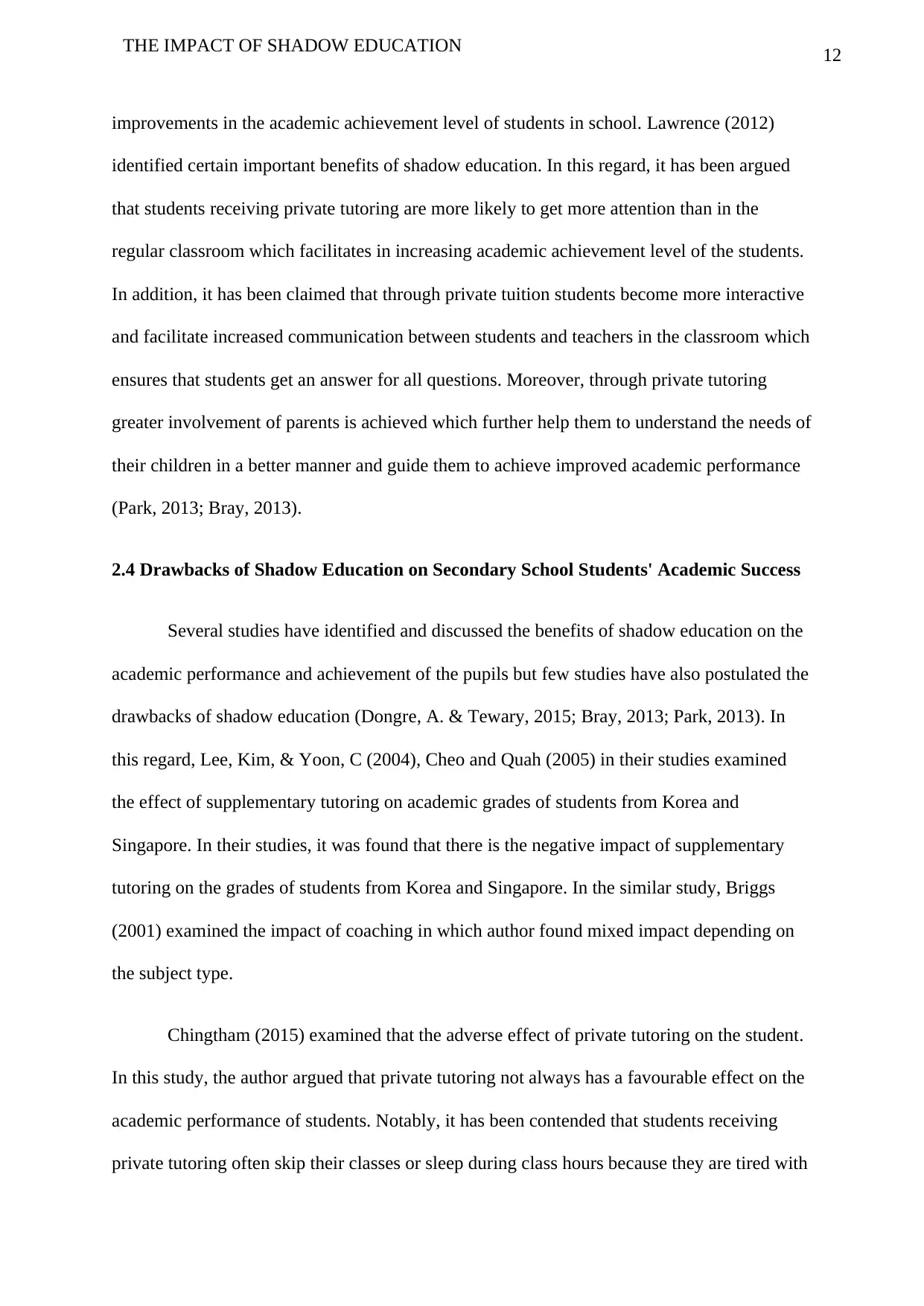
12
THE IMPACT OF SHADOW EDUCATION
improvements in the academic achievement level of students in school. Lawrence (2012)
identified certain important benefits of shadow education. In this regard, it has been argued
that students receiving private tutoring are more likely to get more attention than in the
regular classroom which facilitates in increasing academic achievement level of the students.
In addition, it has been claimed that through private tuition students become more interactive
and facilitate increased communication between students and teachers in the classroom which
ensures that students get an answer for all questions. Moreover, through private tutoring
greater involvement of parents is achieved which further help them to understand the needs of
their children in a better manner and guide them to achieve improved academic performance
(Park, 2013; Bray, 2013).
2.4 Drawbacks of Shadow Education on Secondary School Students' Academic Success
Several studies have identified and discussed the benefits of shadow education on the
academic performance and achievement of the pupils but few studies have also postulated the
drawbacks of shadow education (Dongre, A. & Tewary, 2015; Bray, 2013; Park, 2013). In
this regard, Lee, Kim, & Yoon, C (2004), Cheo and Quah (2005) in their studies examined
the effect of supplementary tutoring on academic grades of students from Korea and
Singapore. In their studies, it was found that there is the negative impact of supplementary
tutoring on the grades of students from Korea and Singapore. In the similar study, Briggs
(2001) examined the impact of coaching in which author found mixed impact depending on
the subject type.
Chingtham (2015) examined that the adverse effect of private tutoring on the student.
In this study, the author argued that private tutoring not always has a favourable effect on the
academic performance of students. Notably, it has been contended that students receiving
private tutoring often skip their classes or sleep during class hours because they are tired with
THE IMPACT OF SHADOW EDUCATION
improvements in the academic achievement level of students in school. Lawrence (2012)
identified certain important benefits of shadow education. In this regard, it has been argued
that students receiving private tutoring are more likely to get more attention than in the
regular classroom which facilitates in increasing academic achievement level of the students.
In addition, it has been claimed that through private tuition students become more interactive
and facilitate increased communication between students and teachers in the classroom which
ensures that students get an answer for all questions. Moreover, through private tutoring
greater involvement of parents is achieved which further help them to understand the needs of
their children in a better manner and guide them to achieve improved academic performance
(Park, 2013; Bray, 2013).
2.4 Drawbacks of Shadow Education on Secondary School Students' Academic Success
Several studies have identified and discussed the benefits of shadow education on the
academic performance and achievement of the pupils but few studies have also postulated the
drawbacks of shadow education (Dongre, A. & Tewary, 2015; Bray, 2013; Park, 2013). In
this regard, Lee, Kim, & Yoon, C (2004), Cheo and Quah (2005) in their studies examined
the effect of supplementary tutoring on academic grades of students from Korea and
Singapore. In their studies, it was found that there is the negative impact of supplementary
tutoring on the grades of students from Korea and Singapore. In the similar study, Briggs
(2001) examined the impact of coaching in which author found mixed impact depending on
the subject type.
Chingtham (2015) examined that the adverse effect of private tutoring on the student.
In this study, the author argued that private tutoring not always has a favourable effect on the
academic performance of students. Notably, it has been contended that students receiving
private tutoring often skip their classes or sleep during class hours because they are tired with
⊘ This is a preview!⊘
Do you want full access?
Subscribe today to unlock all pages.

Trusted by 1+ million students worldwide
1 out of 41
Related Documents
Your All-in-One AI-Powered Toolkit for Academic Success.
+13062052269
info@desklib.com
Available 24*7 on WhatsApp / Email
![[object Object]](/_next/static/media/star-bottom.7253800d.svg)
Unlock your academic potential
Copyright © 2020–2025 A2Z Services. All Rights Reserved. Developed and managed by ZUCOL.





